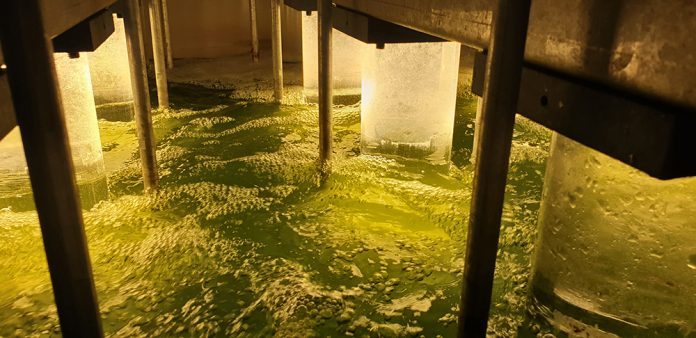Severn Trent has launched a pioneering research programme to find new ways to reduce the amount of phosphorus in wastewater.
Even though we are only just a few months into the new AMP, by the end of AMP7 water companies up and down the country will be asked to reduce levels of phosphorus in their wastewater catchments that serve rural communities. For Severn Trent, this means finding a low cost and low carbon solution across 100 of its 750 rural catchments…
The Challenge
The conventional approach to controlling phosphorus levels is using iron or aluminium-based coagulants. This approach is effective but, it has a high carbon footprint and high operating costs. Severn Trent also recognises that the significant increase in demand for iron and aluminium-based coagulants across the water industry is a business risk which must be carefully managed.
Emily Timmins, Severn Trent’s Head of Wastewater Recycling, believes that identifying alternative ways to control phosphorus in rural wastewater catchments is a key opportunity to build resilience, reduce costs and deliver a lasting environmental and societal benefit.
Emily said: “The cost of running a rural wastewater treatment works is largely made up of maintenance visits and sludge collections. Chemical-based phosphorus removal solutions will only increase these costs.
“Our long-term ambition for rural wastewater catchments is to use systems that are carbon neutral, require minimal operator intervention and deliver added value to the communities they serve.
“This vision will help deliver the company’s Triple Carbon Pledge, which includes a commitment to be carbon neutral by 2030, and our Great Big Nature Boost which will deliver biodiversity improvements to 5000 hectares during AMP7.”
Finding a solution
Severn Trent’s approach to innovation means it can research and develop new solutions, experiment with ideas that already exist across the globe and adopt them quickly.
The company is working with water companies across the world, as well as academia, its supply chain, landowners and regulators, recognising that all these stakeholders have a part to play in establishing a toolkit of solutions which deliver net environmental gains and value to the communities Severn Trent serves.
What’s happening now…
Today, Severn Trent already uses wetland technologies, ranging from reed beds to facultative ponds, to deliver low carbon treatment across its estate. Recent research on Free Water Surface Wetlands (FWSW) for wastewater treatment has highlighted their ability to passively deliver water quality improvements and reinstate biodiverse habitats with socio-economic enhancements.
Emily said: “We’ve assessed the potential of wetland technologies through a series of knowledge exchange visits with other water companies and we’re now working with River Ecosystem Services (part of the Rivers Trust) to carry out detailed feasibility studies for six FWSW opportunities.
“Involving the Rivers Trust at an early stage in the projects has enabled us to use their local and ecological knowledge to inform design proposals and capitalise on opportunities to improve biodiversity in the surrounding area.”
Working in partnership with the agricultural community and implementing catchment interventions has helped Severn Trent to protect potable water supplies. It believes using a similar approach in rural wastewater catchments provides an opportunity to manage phosphorus loads upstream of their wastewater treatment works. This allows Severn Trent to benefit from a more flexible permitting approach, as well as avoiding traditional chemical treatment solutions.
Severn Trent is also working with farmers, landowners and NGO’s to limit phosphorus inputs at source, or to disrupt the transport and delivery of phosphorus to the watercourses. Emily explains: “Opportunity mapping and targeting interventions in higher risk areas provides us with the biggest benefit and using nature-based solutions provide wider environmental and community-based benefits to an area.
“This includes increases in biodiversity, flood relief, recreation, engagement with our communities and ultimately a more resilient environment.”
Reactive media and algae treatment
Severn Trent is also working to identify materials known as reactive media that can remove phosphorus from wastewater through adsorption and precipitation mechanisms. Reactive media can be a naturally occurring mineral, for example apatite, or a waste product like steel slag, and should be deployed in large passive treatment beds to deliver long term, low cost and low carbon treatment.
After a full-scale trial with steel slag media proved to be unsuccessful, Severn Trent worked with its supply chain and academia to develop other media which deliver good phosphorus capture, are mechanically robust and have the potential to form part of a circular economy supply chain.
Algae treatment is another approach the Midlands-based company has taken in its search to reduce Phosphorus levels. Algal requires substrate, light and carbon dioxide to grow and in the process create oxygen and removes both phosphorus and nitrogen.
Emily said: “Processes which use algae to capture phosphorus are ideal polishing steps for our existing treatment works. Algal processes won’t require any chemicals and produce a biomass by-product with circular economy potential.
“We’re working with universities and technology developers to focus on innovative approaches where the algae is conditioned before being introduced to effluent in order to achieve low phosphorus levels.”
Although Severn Trent has assessed market ready technologies, developed low TRL ideas with universities and identified offsetting strategies that capture phosphorus in the local catchment, their search for the right toolkit continues. To work with Severn Trent, please contact them through their website
www.severntrent.com/innovation



